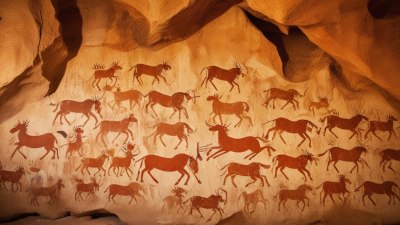Exploring Local Creation Stories Through Cave Painting Tours
Discover the fascinating connection between local cultures and their creation stories through cave painting tours. Learn more!

Image created with Flux Schnell
Cave painting tours offer a unique glimpse into the historical and cultural significance of ancient art. Throughout history, humans have turned to their surroundings, experiences, and spirituality to express their beliefs. One of the most compelling ways to understand local creation stories is through the art left behind in caves. These ancient paintings provide insights into the beliefs, values, and mythology of the people who created them. This article will explore the significance of cave paintings, the narratives they depict, and how they can connect us to the creation stories of local cultures.
The tradition of cave painting can be traced back tens of thousands of years. The earliest known cave paintings date back to approximately 40,000 years ago, found mainly in Europe and parts of Asia. However, cave art exists on every continent, with unique styles and themes reflecting the region's cultural heritage. In many cases, these paintings depict stories of gods, creation, animals, and the interaction between humans and the natural world, forming a tapestry of mythology that provides insight into the worldview of ancient peoples.
Understanding the Role of Mythology in Creation Stories
Creation stories are foundational myths that explain how the world and humanity came into being. They are often closely tied to the identity of the people who tell them, encapsulating their values, beliefs, and understanding of their environment. Almost every culture across the globe has its own creation story, and these narratives often feature elements of the natural world, such as animals, celestial bodies, and the Earth itself. Through the lens of these myths, we see how different cultures understand their place in the universe.
Cave paintings serve as visual representations of these creation stories, acting as a bridge between the past and the present. The images found in caves often depict the creatures and natural elements that feature prominently in local myths—animals that may be revered or feared, celestial entities that guide the seasons, or even ancestral figures that connect current generations to their forebears. By revisiting these sites, we can glean insights into how our ancestors interpreted their world and the narratives they passed down through generations.
Exploring Cave Paintings Through Tours
Cave painting tours have become a popular way for both locals and tourists to engage with their heritage. Many regions known for their cave art offer guided tours led by knowledgeable experts who can share the significance behind the paintings and the cultural context in which they were created. These tours not only provide education about the artwork itself but also illuminate the creation stories and myths associated with them.
Across the globe, from the Lascaux caves in France to the Aboriginal rock art in Australia, each location has its unique approach to storytelling through art. Tour participants are encouraged to appreciate the intricate details of the cave paintings, understanding that what they see is not just art but a representation of ideas and beliefs that are central to a culture's identity. These tours can also emphasize the importance of conservation and the need to protect these cultural treasures for future generations.
Significant Cave Painting Sites and Their Stories
There are numerous famous cave painting sites around the world, each with its rich narrative and local significance. For instance, the Altamira Cave in Spain is renowned for its stunning depictions of bison, showcasing how these creatures were central to the lives of the people who painted them. The artists at Altamira likely understood the bison's importance for sustenance and society, leading to the creation of art that immortalized these animals, contributing not only to hunting lore but also to a cultural identity focused on the earth and its resources.
Similarly, the Cave of Forgotten Dreams in France, which houses paintings believed to be over 32,000 years old, provides a window into the early human psyche and its relationship with nature and spirituality. Some experts suggest that the intricate designs and repeated motifs found in these caves may have had ritualistic significance, playing a part in creation myths or spiritual practices that connected these early people to the cosmos.
In Australia, Aboriginal rock art offers profound insights into the creation stories of various Indigenous cultures, portraying Dreamtime narratives that speak of ancestors, spiritual beings, and the formation of the landscape. Many of these artworks depict natural phenomena, such as waterholes or rock formations, integral to the creation beliefs of the Aboriginal peoples. These tours not only educate participants about the rich tapestry of Aboriginal culture but also advocate for respect and recognition of Indigenous histories and their continuous connection to the land.
The Impact of Cultural Preservation
The exploration of cave painting through tours does more than just inform and educate; it plays a vital role in cultural preservation. Many Indigenous communities are actively working to preserve their heritage by sharing their stories and histories through art. Such efforts are crucial in today's world, where globalization and modernization can threaten to overshadow local narratives and traditions.
Cave painting tours can save these traditions by fostering an appreciation for local histories and promoting respectful engagement with Indigenous cultures. When guided by local experts, these tours can uplift the voices of Indigenous peoples, allowing them to tell their stories in authentic and meaningful ways. This not only helps in preserving the culture but also gives visitors a more profound understanding of the interconnectedness of art, identity, and place.
Engaging with Creation Stories
Engaging with cave paintings through tours provides a rare opportunity to connect with creation stories and the cultural identities that surround them. These ancient artworks are a testament to the enduring relationship between humanity and the natural world, offering us insights into our past and guiding us in understanding our present. By participating in cave painting tours, we contribute to the appreciation and preservation of these significant cultural narratives, ensuring that future generations have the opportunity to explore and learn from the wisdom contained within these sacred sites.
Through respectful engagement and education, we not only honor the stories of those who came before us but also foster a greater understanding of the diverse cultures that shape our world today. Visiting cave painting sites is not just about observing ancient art; it's about stepping into a dialogue with history, culture, and the deep human connection to creation stories that have transcended time.











